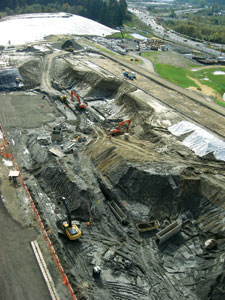Drought, population growth and aging water infrastructure are driving states and municipalities to either begin or build upon ambitious capital campaigns to improve their wastewater and drinking water supply systems, and the outlook for continued growth in the water market looks strong.
McGraw-Hill Analytics reports that in 2006 contracting for sewers, wastewater and hazardous waste projects grew 9%, to $14.5 billion, and the outlook for 2007 and 2008 looks bright. Much of the work in sewer lines stems from more stringent federal and state standards for combined sewer overflows (CSO). A number of municipalities have signed consent decrees with the U.S. Environmental Protection Agency to make improvements to sewer systems to reduce overflows during heavy rain.
 King County Wastewater Treatment Division Moving Earth. King County, Wash. is building $1.7-billion project.
|
Atlanta signed consent decrees with EPA in 1998 and 1999, and is in the midst of a $264.8-million CSO storage tunnel project that will capture up to 177 million gallons of overflow. When completed in November 2008, the 24-ft-dia tunnel will be ready to hold overflow over its 8.5-mile length until capacity is available at the city’s wastewater treatment plants.
This and other sewer rehabilitation and improvement projects have already led to significant CSO reductions, says Rob Hunter, commissioner of Atlanta’s Dept. of Watershed Management. “We’ve reduced the number of overflows in the city from over 1,000 overflow events in 2000 down to fewer than 400 in 2006,” with only 150 events so far in 2007, he says.
The work is part of Atlanta’s $3.9-billion Clean Water Atlanta program, which includes “a lot of infrastructure investment in all our lines, whether they’re sewer or drinking water,” Hunter says. The city has already awarded approximately $1.7 billion and plans to contract out a steady stream of work at least through 2014, Hunter says.
The city of Indianapolis developed a $1.8-billion, 20-year plan to revamp its CSO system in conjunction with a consent decree approved by the EPA in November 2006. The city has incorporated approximately $250 million of already completed work into the plan.
One of the first projects is a more-than-$100-million project that will connect Indianapolis’ two 150-million-gallon-per day wastewater treatment plants with a 6.5-mile-long tunnel. When complete, the 12-ft-dia tunnel will allow operators to send flow to the plant with the most available capacity, reducing overflows into the White River and nearby streams, says Carlton Ray, deputy director of the city’s Dept. of Public Works. The city is currently working on designs for the project, and plans to bid the work out in the second quarter of 2008, Ray says.
Tight Supply
Other drivers fueling growth in the water market are exploding population growth and drought, particularly in the West. States and municipalities increasingly are seeking to stretch limited drinking water supplies further, often turning to innovative recycling and reuse strategies to do more with less.
In November, Orange County, California, is expected to go online with a new $480-million, 70-mgd plant, which the county is calling the largest indirect potable reuse facility of its kind in the world. It combines microfiltration, reverse-osmosis membranes and ultraviolet disinfection to treat wastewater beyond drinking water standards. Walnut, Calif.-based J.F. Shea Construction was the contractor on the project.
The Orange County Sanitation District will pump treated effluent that normally would be discharged to the ocean to the Orange County Water District. Its new plant will take secondary-treated effluent, treat it further, and inject a portion into an expanded seawater intrusion barrier. The injected water will bolster the barrier, which protects the county’s groundwater supplies. The remaining 35 mgd will be pumped through a 13-mile pipeline to percolation ponds, where it will naturally filter into the ground and help augment Orange County’s groundwater basin.
“I think that you will see, particularly once this project goes online and people start seeing what you can do reusing this valuable resource that otherwise you’re wasting that there will be quite a bit [of similar plants] that will pop up all over the place,” says Mike Markus, general manager of the Orange County Water District.
 Water District Orange County will use reverse osmosis to purify water.
|
A Joint Effort
The project is being funded jointly by Orange County’s water and sanitation districts. Markus says the sanitation district provided $266 million, more than half of the project’s funding, to avoid building another ocean outfall that was needed because of wet winter weather that put “so much water into their system that it exceeded the capacity of their existing outfall.” The agreement turned out to be beneficial for both agencies.
Markus notes that the county had to embark on a significant effort to educate the public and community leaders that the project was an indirect reuse of treated...
�
�
Post a comment to this article
Report Abusive Comment